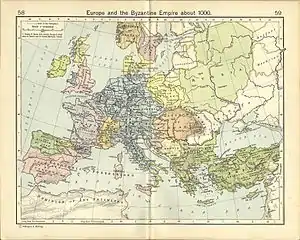1000s (decade)
The 1000s (pronounced “one-thousands”) was a decade of the Julian Calendar which began on January 1, 1000, and ended on December 31, 1009.
| Millennium: | 2nd millennium |
| Centuries: | |
| Decades: | |
| Years: | |
| Categories: |
|
Events
1000
Christendom

In continental Europe, the Holy Roman Empire established itself as the most powerful state. Otto III made a pilgrimage from Rome to Aachen and Gniezno (Gnesen), stopping at Regensburg, Meissen, Magdeburg, and Gniezno. The Congress of Gniezno (with Bolesław I Chrobry) was part of his pilgrimage. In Rome, he built the basilica of San Bartolomeo all'Isola, to host the relics of St. Bartholomew.
In France, Robert II, the son of Hugh Capet, was the first of the Capetian kings.
The Byzantine Empire under the Macedonian dynasty was engaged in a long and hard war with the First Bulgarian Empire. In the year 1000, the Byzantine generals Theodorokanos and Nikephoros Xiphias captured the former Bulgarian capitals of Pliska and Great Preslav, along with Little Preslav, extending Byzantine control over the northeastern portion of the Bulgarian state (Mysia and Scythia Minor). At the same time, Byzantium was instrumental in the Christianization of the Kievan Rus' and of other medieval Slavic states.
In Great Britain, a unified Kingdom of England had developed out of the various Anglo-Saxon kingdoms. In Scandinavia, Christianization was in its early stages, with the Althingi of the Icelandic Commonwealth embracing Christianity in the year 1000.
On September 9, King Olaf Tryggvason was defeated by Denmark and Sweden in the Battle of Svolder. Sweyn I established Danish control over part of Norway. Oslo, Norway, was founded (the exact year is debatable, but the 1,000 year anniversary was held in the year 2000).
The Papacy during this time was in a period of decline, in retrospect known as the saeculum obscurum ("Dark Age") or "pornocracy" ("rule of harlots"), a state of affairs that would result in the Great Schism later in the 11th century.
Hungary was established in 1000 as a Christian state. In the next centuries, the Kingdom of Hungary became the pre-eminent cultural power in the Central European region. On December 25, Stephen I was crowned as the first King of Hungary in Esztergom.
Sancho III of Navarre became King of Aragon and Navarre. The Reconquista was gaining some ground, but the southern Iberian peninsula would still be dominated by Islam for centuries to come; Córdoba at this time was the world's largest city with 450,000 inhabitants.
It is known that in or around this year, Norse explorer Leif Ericson became the first European to land in the Americas, at L'Anse aux Meadows in modern-day Newfoundland.
- The Château de Goulaine vineyard was founded in France.
- The archdiocese in Gniezno was founded; the first archbishop was Gaudentius (Radim), from Slavník's dynasty, and dioceses in Kołobrzeg, Kraków and Wrocław.
- The Bell foundry was founded in Italy by Pontificia Fonderia Marinelli.
Muslim world
The Islamic world was in its Golden Age; still organised in caliphates, it continued to be dominated by the Abbasid Caliphate, with the Caliphate of Córdoba to the west, and experienced ongoing campaigns in Africa and in India. Persia was in a period of instability, with various polities seceding from Abassid rule, among whom the Ghaznavids would emerge as the most powerful.
The Islamic world was reaching the peak of its historical scientific achievements. Important scholars and scientists who flourished in AD 1000 include Abu al-Qasim (Abulcasis), Ibn Yunus (publishes his astronomical treatise Al-Zij al-Hakimi al-Kabir in Cairo in c. 1000), Abu Sahl al-Quhi (Kuhi), Abu-Mahmud al-Khujandi, Abu Nasr Mansur, Abu al-Wafa, Ahmad ibn Fadlan, Al-Muqaddasi, Ali Ibn Isa, and al-Karaji (al-Karkhi). Ibn al-Haytham (Book of Optics), Avicenna, and Abu Rayhan al-Biruni, who all flourished around the year 1000, are considered to be among the greatest scientists of the Middle Ages altogether.
The Turkic migration by this time had reached Eastern Europe, and most of the Turkic tribes (Khazars, Bulghars, Pechenegs etc.) had been Islamized. == {{dr|y|y|{{{year}}}0|{{{1}}}|n{{#ifexpr:{{{year}}}<10|a}}}} == {{trim|{{transcluded section|{{dr|y|y|{{{year}}}0|{{{1}}}|n{{#ifexpr:{{{year}}}<100|a}}}}}} {{#section-h::{{dr|y|y|{{{year}}}0|{{{1}}}|n{{#ifexpr:{{{year}}}<100|a}}}}|Events}}}} == {{dr|y|y|{{{year}}}0|{{{1}}}|n{{#ifexpr:{{{year}}}<10|a}}}} == {{trim|{{transcluded section|{{dr|y|y|{{{year}}}0|{{{1}}}|n{{#ifexpr:{{{year}}}<100|a}}}}}} {{#section-h::{{dr|y|y|{{{year}}}0|{{{1}}}|n{{#ifexpr:{{{year}}}<100|a}}}}|Events}}}} == {{dr|y|y|{{{year}}}0|{{{1}}}|n{{#ifexpr:{{{year}}}<10|a}}}} == {{trim|{{transcluded section|{{dr|y|y|{{{year}}}0|{{{1}}}|n{{#ifexpr:{{{year}}}<100|a}}}}}} {{#section-h::{{dr|y|y|{{{year}}}0|{{{1}}}|n{{#ifexpr:{{{year}}}<100|a}}}}|Events}}}} == {{dr|y|y|{{{year}}}0|{{{1}}}|n{{#ifexpr:{{{year}}}<10|a}}}} == {{trim|{{transcluded section|{{dr|y|y|{{{year}}}0|{{{1}}}|n{{#ifexpr:{{{year}}}<100|a}}}}}} {{#section-h::{{dr|y|y|{{{year}}}0|{{{1}}}|n{{#ifexpr:{{{year}}}<100|a}}}}|Events}}}} == {{dr|y|y|{{{year}}}0|{{{1}}}|n{{#ifexpr:{{{year}}}<10|a}}}} == {{trim|{{transcluded section|{{dr|y|y|{{{year}}}0|{{{1}}}|n{{#ifexpr:{{{year}}}<100|a}}}}}} {{#section-h::{{dr|y|y|{{{year}}}0|{{{1}}}|n{{#ifexpr:{{{year}}}<100|a}}}}|Events}}}} == {{dr|y|y|{{{year}}}0|{{{1}}}|n{{#ifexpr:{{{year}}}<10|a}}}} == {{trim|{{transcluded section|{{dr|y|y|{{{year}}}0|{{{1}}}|n{{#ifexpr:{{{year}}}<100|a}}}}}} {{#section-h::{{dr|y|y|{{{year}}}0|{{{1}}}|n{{#ifexpr:{{{year}}}<100|a}}}}|Events}}}} == {{dr|y|y|{{{year}}}0|{{{1}}}|n{{#ifexpr:{{{year}}}<10|a}}}} == {{trim|{{transcluded section|{{dr|y|y|{{{year}}}0|{{{1}}}|n{{#ifexpr:{{{year}}}<100|a}}}}}} {{#section-h::{{dr|y|y|{{{year}}}0|{{{1}}}|n{{#ifexpr:{{{year}}}<100|a}}}}|Events}}}} == {{dr|y|y|{{{year}}}0|{{{1}}}|n{{#ifexpr:{{{year}}}<10|a}}}} == {{trim|{{transcluded section|{{dr|y|y|{{{year}}}0|{{{1}}}|n{{#ifexpr:{{{year}}}<100|a}}}}}} {{#section-h::{{dr|y|y|{{{year}}}0|{{{1}}}|n{{#ifexpr:{{{year}}}<100|a}}}}|Events}}}} == {{dr|y|y|{{{year}}}0|{{{1}}}|n{{#ifexpr:{{{year}}}<10|a}}}} == {{trim|{{transcluded section|{{dr|y|y|{{{year}}}0|{{{1}}}|n{{#ifexpr:{{{year}}}<100|a}}}}}} {{#section-h::{{dr|y|y|{{{year}}}0|{{{1}}}|n{{#ifexpr:{{{year}}}<100|a}}}}|Events}}}}
Science and technology
- The scientific achievements of the Islamic civilization reach their zenith. Major works from this decade include Ibn al-Haytham (Alhacen)'s Book of Optics, Abu al-Qasim al-Zahrawi (Abulcasis)'s 30-volume medical encyclopedia, the Al-Tasrif.
- Other significant contributions to scientific and mathematical understanding were made by Avicenna, who would later publish influential works on medicine, Persian Muslim polymath and scientist Abu Rayhan al-Biruni, Arab Egyptian Muslim mathematician and astronomer Ibn Yunus, Persian Muslim physicist and mathematician Abu Sahl al-Quhi (Kuhi) and Persian Muslim astronomer and mathematician, Abu-Mahmud al-Khujandi.
- The Law of sines is discovered by Muslim mathematicians.
- Bell foundry is founded in Italy.
- Gunpowder is invented in China.
Significant people
- Abd al-Rahman Ibn Yunus
- Abu al-Qasim al-Zahrawi (Abulcasis)
- Abu-Mahmud al-Khujandi
- Abu Nasr Mansur
- Abu Rayhan al-Biruni
- Alhacen (Ibn al-Haytham)
- Avicenna (Ibn Sina)
- Basil II
- Boleslaus I of Poland
- Brian Boru
- Bruno of Querfurt
- Robert II of France
- Robert Guiscard
- Roger I of Sicily
- Sancho III of Navarre
- Stephen I of Hungary
- Sweyn I of Denmark
- Tsar Samuil of Bulgaria
== {{ucfirst:{{{1}}}}} == {{preprocess|{{((}}transcluding articles {{!}} {{#ifeq:{{{decade}}}|0|{{void|There is no AD year 0}}|{{Year article|{{{decade}}}0}}}} {{!}} {{for loop|{{!}}|call=Year article|pc1n=1|pc1v={{{decade}}}0|pv=2|1|2|3|4|5|6|7|8|9}} {{))}}}} {{#ifeq:{{{decade}}}|0|{{void|There is no AD year 0}}| {{Transclude {{{1}}}|{{{decade}}}0}} }} {{for loop| |call=Transclude {{{1}}}|{{{decade}}}1|{{{decade}}}2|{{{decade}}}3|{{{decade}}}4|{{{decade}}}5|{{{decade}}}6|{{{decade}}}7|{{{decade}}}8|{{{decade}}}9}} == {{ucfirst:{{{1}}}}} == {{preprocess|{{((}}transcluding articles {{!}} {{#ifeq:{{{decade}}}|0|{{void|There is no AD year 0}}|{{Year article|{{{decade}}}0}}}} {{!}} {{for loop|{{!}}|call=Year article|pc1n=1|pc1v={{{decade}}}0|pv=2|1|2|3|4|5|6|7|8|9}} {{))}}}} {{#ifeq:{{{decade}}}|0|{{void|There is no AD year 0}}| {{Transclude {{{1}}}|{{{decade}}}0}} }} {{for loop| |call=Transclude {{{1}}}|{{{decade}}}1|{{{decade}}}2|{{{decade}}}3|{{{decade}}}4|{{{decade}}}5|{{{decade}}}6|{{{decade}}}7|{{{decade}}}8|{{{decade}}}9}}